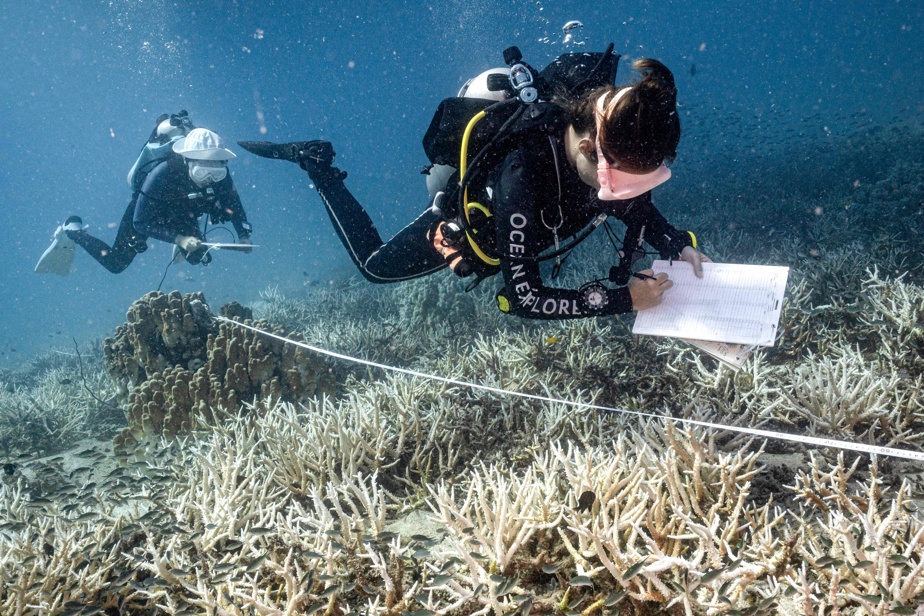(Koh Tao) Off the coast of Koh Tao Island in Thailand, a scuba diver swims slowly above a weakened coral reef with white branches, noting and cataloging the fish species living in this fragile ecosystem.
At only 14 years old, Nannalin Pornprasertsom is one of those scuba divers who are increasingly turning to the conservation of the endangered marine environment rather than simple contemplation.
During a two-week internship, Nannalin learned how to identify coral types, restore reefs and assess the health of a coral by its color, which helps scientific research.
“It’s just something I can do good for the environment,” the teenager, who has been diving since the age of 12, told AFP. “I want to help the reef. »
Around the world, coral is turning ghostly white as the warming ocean expels the microscopic algae that live there, nourish it and give it its color. The coral, deprived of these zooxanthellae which are vital to it, ends up dying.

PHOTO NICHOLAS SHEARMAN, AFP
Two examples of reef restoration methods used to slow their decline and accelerate coral recovery
Death Spiral
Thailand is experiencing the effects of climate change in a range of areas and authorities have already closed several national parks due to recent coral bleaching.
Marine conservation certifications increased by more than 6% globally between 2021 and 2023, according to the Professional Association of Diving Instructors.
This year, it is launching a major census of sharks and rays, exploiting its network of divers to collect data in order to establish protection policies.
On Koh Tao, Black Turtle Dive offers courses on everything from “diving against debris” (collecting plastic or washed-up fishing nets) to coral restoration techniques.
“There is increased awareness,” says Steve Minks, a certified conservation instructor at Black Turtle.
“There is a lot of (coral) bleaching and there is a lot of concern about the marine environment. »
This death spiral is omnipresent in the waters of Koh Tao. The species most affected are branched species which grow quickly, but are also less resistant.
If the water temperature drops, they will have a chance to recover. But for now, their pale stems are visible from the surface.
“I was not prepared for such a significant loss. The impact is considerable,” sighs Sandra Rubio, instructor.
According to the 28-year-old, bleaching and other marine degradation have led divers to take her conservation courses.
“People want to learn because they see these kinds of changes,” she explains to AFP.
“They don’t necessarily understand the origins of it, but they see clearly that there’s nothing good about it. »

PHOTO LILLIAN SUWANRUMPHA, AGENCE FRANCE-PRESSE ARCHIVES
Nannalin Pornprasertsom and Sandra Rubio
She explains to her trainees how to identify species, including soft coral: wave at it, she explains, imitating the movement of a hand in the water, and wait to see if it “waves back.”
The information collected by the young Nannalin will be integrated into a global, collaborative scientific project called Coral Watch, which has already produced numerous publications.
“We collect data for scientists so they can work with governments and authorities,” says Steve Minks.
Divers also carry out coral restoration and planting activities. On board a boat, a star-shaped structure designed by students is transported to a coral reef.
“We do our best”
Over the past 14 months, the environmental association Global Reef has transplanted around 2,000 coral colonies, with a survival rate of around 75%, says Gavin Miller, director of the scientific program.
“It’s not really going to save coral reefs on a global scale, but it has a very, very big impact locally. »
“The snappers (reef fish, Editor’s note) are coming back. We also have puffer fish. »
Coral bleaching has discouraged many sea enthusiasts, but for Koh Tao divers, it is also a call for general mobilization.
“Previous generations did not have access to the research and education we have today.” “I think people my age should make the most of it and do their best to turn things around,” says Nannalin.
Sandra Rubio admits with sadness that this “is not going to change overnight”, “but we are doing our best, and it is a very strong feeling”, she says.
To boost her morale, she “works every day”: “to do good for the environment and the reef that I love”.
